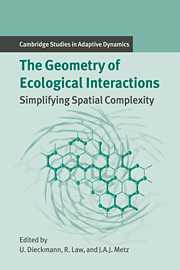Book contents
- Frontmatter
- Contents
- Contributing Authors
- 1 Introduction
- Part A Empirical and Statistical Background: A Plant Ecological Perspective
- Part B When the Mean-field Approximation Breaks Down
- Part C Simplifying Spatial Complexity: Examples
- Part D Simplifying Spatial Complexity: Techniques
- Introduction to Part D
- 18 Pair Approximations for Lattice-based Ecological Models
- 19 Pair Approximations for Different Spatial Geometries
- 20 Moment Methods for Ecological Processes in Continuous Space
- 21 Relaxation Projections and the Method of Moments
- 22 Methods for Reaction–Diffusion Models
- 23 The Dynamics of Invasion Waves
- 24 Epilogue
- References
- Index
- International Institute for Applied Systems Analysis
24 - Epilogue
Published online by Cambridge University Press: 14 January 2010
- Frontmatter
- Contents
- Contributing Authors
- 1 Introduction
- Part A Empirical and Statistical Background: A Plant Ecological Perspective
- Part B When the Mean-field Approximation Breaks Down
- Part C Simplifying Spatial Complexity: Examples
- Part D Simplifying Spatial Complexity: Techniques
- Introduction to Part D
- 18 Pair Approximations for Lattice-based Ecological Models
- 19 Pair Approximations for Different Spatial Geometries
- 20 Moment Methods for Ecological Processes in Continuous Space
- 21 Relaxation Projections and the Method of Moments
- 22 Methods for Reaction–Diffusion Models
- 23 The Dynamics of Invasion Waves
- 24 Epilogue
- References
- Index
- International Institute for Applied Systems Analysis
Summary
We would like to close this volume with a look at the future of mechanistic modeling in spatial ecology. We hope that at least some of the optimistic views sketched below come true. No doubt others, hopefully fewer, will turn out to be mirages.
Just as theory is at its best when it is demonstrably applicable to real ecological systems, field research is most important when it addresses questions that clearly transcend a particular study system. Few researchers, however, have sufficient command of both theory and experiment to actively participate at the two research fronts. It is therefore essential to extend chains of collaboration between empiricists and theorists. These chains should not become too long lest they break or the message passed along becomes too garbled. If such collaborative chains are to work effectively, each partner must have a good understanding of the others' vocabulary, basic concepts, and techniques.
One of this book's objectives is to foster dialogue between those researchers with empirical competence and those with theoretical skills in the field of spatial ecology. In practice, there is still an appreciable distance between the detailed investigations of plant interactions reported in Part A of this volume and the mathematical methods advanced in Part D. However, ecological theory is making great strides toward integrating more ecological realism into manageable models. Theorists and empiricists alike are searching for new kinds of models that are better able to account for the complex implications of spatial heterogeneity.
- Type
- Chapter
- Information
- The Geometry of Ecological InteractionsSimplifying Spatial Complexity, pp. 513 - 516Publisher: Cambridge University PressPrint publication year: 2000

